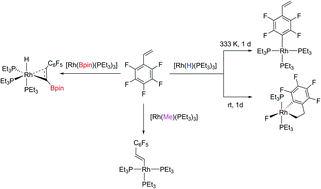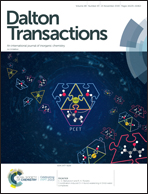Abstract
The rhodium(I) complexes [Rh(Bpin)(PEt3)3] (1), [Rh(H)(PEt3)3] (5) and [Rh(Me)(PEt3)3] (14) were employed in reactions with pentafluorostyrene affording coordination of the olefin and C–F or C–H bond activation. Control of the reaction conditions allowed for selective activation reactions at different positions at the fluorinated aromatic ring. The rhodacycle trans-[Rh(F)(CH2CH2(2-C6F4))(PEt3)2] (7) was identified as an intermediate for an activation at the 2-position. Reactivity studies of the latter with CO led to the generation of trans-[Rh(F)(CH2CH2C6F4)(CO)(PEt3)2] (10). Stoichiometric and catalytic hydroboration reactions were achieved using complexes 1 or 5 as catalysts.

- This article is part of the themed collections: Spotlight Collection: Fluorinated ligands and Breaking bonds over many timescales: in celebration of Robin Perutz’s 70th birthday


 Please wait while we load your content...
Please wait while we load your content...